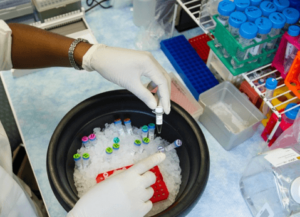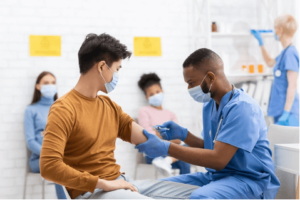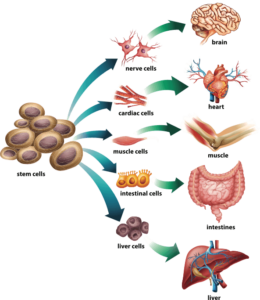
In order to deliver quality health care to you and your family, medical professionals rely on research. Today, we explore how researchers make new discoveries, current tools for LDS research, and LDSF Canada’s upcoming research award, the LEAP Impact Award.
What is research?
Research is a step-by-step process where investigators collect, document, and analyze data to confirm previous work or make new discoveries. Medical research aims to improve health care and the results of medical research can be used to prevent disease, provide an early and correct diagnosis, and care for patients and families.
Why is research important?
LDS research helps the medical world, the LDS community, patient advocacy groups, and the general public learn about new and improved ways to diagnose, treat, and manage LDS. With more funding and LDS research, LDS findings can continue to evolve, and medical care can continue to improve.
Who pays for research?
We all do. Research is largely funded by federal or provincial government grants, private companies, and non-profit organizations. By paying taxes, buying products from companies, and donating to charity, we all help to fund research.
Does LDSFC fund research?
On January 24, 2022, we are opening applications for our LEAP Impact Award. We will provide up to four seed grants of $25 000 US to support research into LDS and related disorders. Award recipients will also receive tools to help them with professional growth, personal development, and securing more funding,
When looking for funding, researchers typically start by applying for small amounts of money, such as a seed grant. Then, as their project grows in scope and complexity, they may apply for intermediate grants ($50 000 to $200 000) and major funding ($500 000 and more).
Types of research
There are three main types of medical research: basic, clinical, and translational.

Basic research usually asks the question: how or why does this work? It often occurs in a laboratory and involves research into the molecules and structures of cells. For example, a researcher studying LDS might try to find out where and how an LDS-causing mutation occurs in the TGFB2 gene.
Clinical research involves people, and includes clinical trials. Clinical trials are used to see if an intervention like a medical device or drug is safe and effective in humans. There are four phases of clinical trials. If an intervention performs well or better than existing interventions after Phase 3, it can be approved by Health Canada (or, in the United States, by the FDA) and be made available to the public.
Translational research bridges the gap between basic research (in a laboratory) and clinical research (in humans). For example, if a basic researcher identifies an LDS-causing mutation, a translational researcher could explore how different drugs or methods are able to counter the effect of the mutation. If their research is successful in cells, tissue samples, or animals, then the research might advance to a clinical trial.
Translational research also links clinical trials to the real world. For example, a translational researcher could study how the interventions and guidelines from a clinical trial can be used by real-world medical professionals.
How is research published?
If an investigator thinks their research has an important or interesting finding, they can write and submit an article about their research to a journal. The journal will usually conduct a peer review process, where experts review the study results and decide whether or not to publish the study. If research is published, medical professionals can find it in journals they subscribe to, or on online databases. Published research is the best way to validate and communicate research findings.
Why do investigators use model organisms?
When researchers are looking to understand certain topics in biology, such as how molecules function in a cell or how organisms develop, they may conduct their research on a model organism like bacteria, yeast, flies, worms, or mice.
Why use a model organism?
- Because they are easy to research: Model organisms are inherently easier to research than other organisms because they are smaller, simpler, easier to manipulate, and grow or replicate more quickly.
- Because they are similar to other organisms: They share cellular and developmental similarities with other, more complex organisms like humans, and so can be used as models to learn about many other organisms.
Over the years, certain model organisms became very popular for use in research. As model organisms, they were convenient to use in research, and became more popular as more and more scientists studied them and created organism-specific research tools and resources. For example, genomic sequencing (determining the entire sequence of an organism’s genome) is considered to be one of the most important tools in biomedical research. Commonly-used model organisms were among the first organisms to be sequenced. This was very useful to researchers and so these organisms became even more commonly-used research subjects.
Today, as tools like genomic sequencing becomes less expensive and more accessible, researchers have the opportunity to sequence and study less-commonly used model organisms. This is important because studying a larger variety of model organisms allows investigators to answer a wider range of scientific questions and make discoveries that apply to more people.
Model organisms and LDS research
A mouse model of LDS is a mouse used in laboratory research experiments to study LDS. The mouse may have an LDS-causing mutation and an LDS phenotype (physical manifestations of LDS).
Researchers have used a mouse model of LDS to study cardiovascular, skeletal, immune, and craniofacial effects of LDS.
Why do investigators use stem cells?
Stem cells are a general, unspecialized type of cell in the body. They are the only type of cell with the natural ability to undergo a process called differentiation and become a specialized type of cell, such as a bone cell, blood cell, or heart muscle cell.
Why are stem cells used in research? They can be used to understand how diseases develop, to test new drugs and treatments, and to replace damaged or diseased tissue in the body.

Stem cells and LDS research
In a recent study from August 2021, researchers used specialized cells to create stem cells with an LDS-causing mutation in the TGFBR1 gene. They observed the effects of the mutation and explored treatments to reverse these effects.
A look to the future
Stay tuned for more information about our LEAP Impact Award, current LDS research, and future funded projects. We are excited to share this next chapter with all of you.
Bai X. 2020. Stem Cell-Based Disease Modeling and Cell Therapy. Cells. 9(10):2193. https://www.ncbi.nlm.nih.gov/pmc/articles/PMC7599677/
Dana-Farber Cancer Institute. 2017. Basic, Clinical and Translational Research: What’s the Difference? [updated 2018 Nov 16; cited 2021 Dec 7]. Available from: https://blog.dana-farber.org/insight/2017/12/basic-clinical-translational-research-whats-difference/
Dewan AK et al. 2015. Dysregulated TGF-B signaling alters bone microstructure in a mouse model of Loeys-Dietz syndrome. Journal of Orthopaedic Research. 33(10):1447-54. https://pubmed.ncbi.nlm.nih.gov/26173585/
Encyclopedia Britannica. Scientific Method. [cited 2021 Dec 7]. Available from: https://www.britannica.com/science/scientific-method
Gallo MacFarlane E et al. 2019. Lineage-specific events underlie aortic aneurysm pathogenesis in Loeys-Dietz syndrome. The Journal of Clinical Investigation. 129(2):659-675. https://www.ncbi.nlm.nih.gov/pmc/articles/PMC6355234/
Government of Canada. Clinical trials and drug safety. [updated 2020 May 22; cited 2021 Dec 7]. Available from: https://www.canada.ca/en/health-canada/services/clinical-trials.html
Koch L, Potenski C, Trenkmann M. 2021. Sequencing moves to the twenty-first century. Nature. https://www.nature.com/articles/d42859-020-00100-w
Laky K et al. 2016. TGFBR1M318R+/- Knock-In mice recapitulate the immune phenotype of Loeys-Dietz syndrome. The Journal of Immunology. 196(Issue 1 Supplement). https://www.jimmunol.org/content/196/1_Supplement/193.13
Mayo Clinic. 2019. Stem cells: What they are and what they do. [cited 2021 Dec 7]. Available from: https://www.mayoclinic.org/tests-procedures/bone-marrow-transplant/in-depth/stem-cells/art-20048117
McGill University Health Centre Research Institute. How is a clinical trial planned and carried out? [cited 2021 Dec 7]. Available from: https://rimuhc.ca/where-do-the-ideas-for-trials-come-from#where
National Cancer Institute. Genomic sequencing. [cited 2021 Dec 7]. Available from: https://www.cancer.gov/publications/dictionaries/cancer-terms/def/genomic-sequencing
National Human Genome Research Institute. Mouse Model. [cited 2021 Dec 7]. Available from: https://www.genome.gov/genetics-glossary/Mouse-Model
National Institute on Aging. 2020. What Are Clinical Trials and Studies? [updated 2020 Apr 9; cited 2021 Dec 7]. Available from: https://www.nia.nih.gov/health/what-are-clinical-trials-and-studies
Nature. Medical research. [cited 2021 Dec 7]. Available from: https://www.nature.com/subjects/medical-research
Rohrig B et al. 2009. Types of Study in Medical Research. Deutsches Arzteblatt International. 106(15):262-268. https://www.ncbi.nlm.nih.gov/pmc/articles/PMC2689572/
Russell JJ et al. 2017. Non-model model organisms. BMC Biology. 15(55). https://bmcbiol.biomedcentral.com/articles/10.1186/s12915-017-0391-5
University of California at Berkeley. Who pays for science? [cited 2021 Dec 7]. Available from: https://undsci.berkeley.edu/article/who_pays
Yamada S et al. 2021. Mouse Model of Loeys-Dietz Syndrome Shows Elevated Susceptibility to Periodontitis via Alterations in Transforming Growth Factor-Beta Signaling. Frontiers in Physiology. https://www.frontiersin.org/articles/10.3389/fphys.2021.715687/full
Zhou D et al. 2021. hiPSC Modeling of Lineage-Specific Smooth Muscle Cell Defects Caused by TGFBR1A230T Variant, and Its Therapeutic Implications for Loeys-Dietz Syndrome. Circulation. 144(14):1145-1159. https://www.ahajournals.org/doi/abs/10.1161/CIRCULATIONAHA.121.054744

